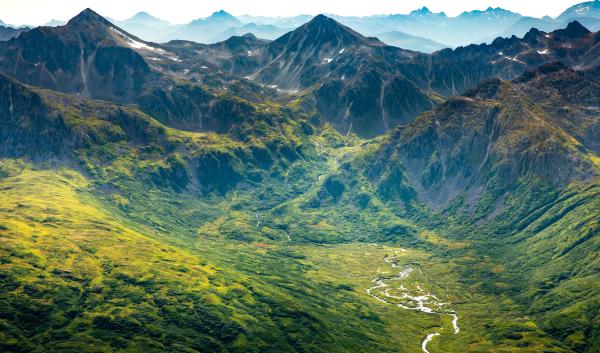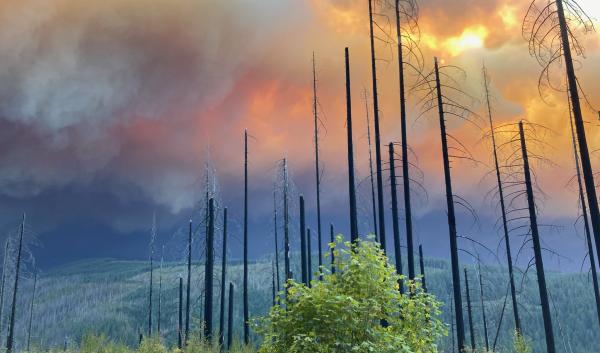Estimated reading time: 7 minutes

Wildfires are a natural part of boreal forest and tundra ecosystems in Alaska. Climate change is increasing the risk of large, frequent, and severe wildfires as rapidly warming temperatures and longer growing seasons affect Alaska. Larger, more frequent, and more severe wildfires threaten lives, infrastructure, and resources.
Wildfire severity differs across ecosystems, from low-severity burns set by Alaska Native communities to low-frequency, high-severity crown fires of the boreal forest. However, fire frequency and burned area throughout Alaska are exceeding those of historical fire regimes. From 2000 to 2020, 2.5 times more acres burned than in the previous 20 years, and 3 of the 4 highest-acreage fire years have occurred since 2000. Most of this increase in area burned has been in tundra and boreal forest. Unlike boreal forest and tundra, Alaska’s temperate rainforests rarely experience fire and have not yet seen an uptick in the number, size, or severity of wildfires.
By 2050, burned area is projected to increase by 24 to 169% in Alaska. Changes in climate will cause longer wildfire seasons, increased fire frequency, size, and total area burned, and possibly increased wildfire severity.Several climate-related factors contribute to changes in wildfire patterns in Alaska:
- Increased temperature and drought
- Shortening snow season
- Warmer nights
As these factors continue to affect Alaskan ecosystems, fires can start and spread more easily. In the past 20 years, Alaska has seen the largest wildfire (Taylor Complex – 2004), largest tundra wildfire (Anaktuvuk River Fire – 2007), and the most expensive fire suppression (Swan Lake – 2019) in recorded history.

How will changing wildfire patterns affect Alaskan boreal forests and tundra?
Shift from Conifers to Hardwoods in Boreal Forests: Increasing fire severity in the Interior has led to a shift from spruce-dominated boreal forests to deciduous forests of birch and aspen. Spruce-dominated forests develop a deep layer of duff, a mossy organic layer that insulates underlying roots and permafrost. High-latitude duff stores about 30-40% of Earth’s soil organic carbon. Fire burns duff, reducing the insulation that protects permafrost from warming temperatures and leading to permafrost thaw. Deciduous trees prefer warmer and nutrient-rich environments, and do not support the development of thick duff. Deciduous forests require more water than coniferous forests, requiring 25% of available spring snowmelt water, whereas spruce forests require only 1%. Some wildlife, like moose, may benefit from a change in forest composition. However, species like caribou, which depend upon lichens for winter survival, could suffer because lichens are damaged during wildfire.

Thawing Permafrost: Although warming temperatures are the primary driver of permafrost thaw in Alaska, wildfires accelerate the rate of thaw by removing duff. Permafrost thaw can also cause thermokarst, a terrain type characterized by irregular surfaces of marshy hollows and small hummocks. Thermokarst can cause the rapid draining of lakes, pockmarked landscapes, landslides, and damage to infrastructure. Thermokarst has accelerated by more than 60% since 1950. Water that would have remained on the surface of permafrost could drain, causing drier vegetation (both living and dead) and increased flammability, and increasing the likelihood of wildfire.
Permafrost is a large terrestrial carbon sink. When permafrost thaws, it releases carbon dioxide and methane. Thawed and degraded permafrost is likely to increase the amount of these greenhouse gases in the atmosphere, accelerating climate change.
Increased Tundra Burning: Warming temperatures and increased drought have contributed to an increase in wildfires in the tundra. By 2100, tundra fires are expected to burn twice as much acreage and 4 times more frequently than historical fire. Increased summer precipitation and severe wildfire have expanded the area covered by shrubs in the upland Arctic tundra, which could increase the likelihood of future wildfire.
Increased wildfire in the tundra could have negative effects on humans and wildlife. Lichens and mosses are severely impacted by wildfire and can be reduced or eradicated for decades after a fire, affecting wildlife such as caribou. Human health could be affected negatively by lower wildlife numbers, increased temperatures, and increased smoke.

Reburns, Fire Return Intervals, and Holdover Fires: Warmer temperatures and drier conditions are expected to increase fire frequency in Alaskan tundra and forests. Wildfires are also more likely to return to areas that have been recently burned. The tundra has experienced an increase in fire reburns since 1997, with implications for slow-growing tundra vegetation. In addition, reburns and shorter fire return intervals could accelerate a shift in species composition from coniferous to deciduous trees in Alaska’s boreal forests.
Holdover fires, or fires that smolder in the duff under the snow through winter and continue burning into the next wildfire season, have occurred in Alaska and other high latitude regions for decades. However, holdover fires are more likely to occur after years with high area burned (e.g., 2005 and 2015), which have grown increasingly common.
Increased Smoke: As Alaskan wildfires have become more frequent and severe, smoke from wildfires is also increasing, with implications for human health, particularly for Alaska Natives and other rural residents. Wildfire smoke is comprised of particles small enough to enter the lungs and bloodstream and can harm the cardiovascular system. Wildland firefighters, children, elders, and the sick are particularly vulnerable to the effects of smoke inhalation. Smoke can limit visibility and impede air travel, affecting transport of supplies to rural villages during wildfire season. With increased fire frequency and size, Alaskans’ exposure to smoke is expected to increase by 100% or more by mid-century.
Contributing Factors
- Lightning-caused Wildfires: Lightning-caused fires burn the most acreage in Alaska.
- Human-caused Wildfires: Though lightning-caused fires tend to burn more acreage in Alaska, human-caused fires are more likely to be ignited near communities and cost more in fire suppression efforts. In some years, human-caused fires outnumber lightning-caused fires.
- Spruce Beetle Outbreaks: Though the spruce beetle is native to Alaska, warmer temperatures and drought have contributed to outbreaks that have killed over a million acres of spruce. Dead, standing spruce are not more flammable than live spruce. However, accumulation of dead trees and limbs on the ground can affect fuels and fire hazard.
Can we attribute recent wildfires to climate change?
Single fires cannot be attributed to climate change unless a thorough, scientific attribution analysis of fire conditions is conducted. For example, climate change contributed to the occurrence of Alaska’s severe fire season of 2015, in which 5.1 million acres burned. Likewise, climate change also played a role in the severe 2019 fire season, in which 2 million acres burned and Alaska experienced its most expensive fire ever. Many recent trends in wildfire are consistent with climate change projections and what is expected in the future.
What can we do about climate change and wildfire in Alaska?
Under a changing climate, Alaska fire managers may need to consider increasing adaptation practices and adopting new approaches to fire management. Adaptation strategies that can increase forest resilience and decrease wildfire intensity in the boreal forest include forest thinning and prescribed fire. Managers can also implement shaded fuel breaks around valued resources. Remote sensing can help fire managers combat wildfires in remote or difficult-to-access areas. For post-fire restoration, managers may want to consider reforestation efforts. Managers can choose genotypes or species that are adapted to current and future climates.
Landowners can protect their own property by using fire resistant building materials, clearing a natural firebreak around their homes, thinning and removing brush, and moving combustible materials away from the home.
Alaska Fire Science Consortium – An organization that works to bridge the gap in boreal and arctic fire science delivery, outreach, and application.
Alaska’s Changing Wildfire Environment – The International Arctic Research Center created a resource that discusses the implications of climate change on Alaskan wildfires.
Braiding Indigenous and Western Knowledge for Climate-Adapted Forests – A report from the USDA Forest Service Pacific Northwest Research Station, Oregon State University, and University of Washington that includes guidance on how to blend indigenous and western knowledge to adapt boreal forests to changing wildfire patterns associated with climate change.
Northwest Wildland Fire Smoke Information – provides Alaska-specific current and forecasted smoke conditions along with other state in the Northwest Climate Hub region.
Shovel Creek Story Map: Burn Severity Explained – An Alaska Fire Science Consortium examination of burn severity on the 2019 Shovel Creek Fire near Fairbanks, Alaska.
Firewise promotes fire safety in the wildland urban interface (WUI) and helps communities to implement fire safe practices in Alaska.
Prescribed Fire in the Northwest – a Northwest Climate Hub website that explains the history, advantages, and disadvantages of prescribed fire in the Northwest.
-
Alaska and a Changing Climate
Rapid warming and changing precipitation patterns in Alaska affect communities, industry, and natural resources.
-
Wildfire and Invasive Plants in Alaska’s Boreal Forest
Burned areas in Alaskan boreal forests are susceptible to invasion from non-native plant species.
-
Climate Change and Wildfire in Idaho, Oregon, and Washington
Large fires in Idaho, Oregon, and Washington are associated with warm and dry conditions that are likely to increase with climate change.





